
Beast Wars: Transformers is an animated television series that debuted on September 16, 1996 and ended on May 7, 1999, serving as the flagship of the Transformers: Beast Wars franchise. It was one of the earliest fully CGI television shows. The series is set in the future of the "original" Transformers franchise, 300 years after the events of The Transformers, and features the Maximals and Predacons, descendants of the Autobots and Decepticons respectively. While engaged in battle, small teams from each faction crash land on an unknown planet, and must find a way to return home while continuing their war.

X-Men vs. Street Fighter is a crossover fighting video game developed and published by Capcom. It is Capcom's third fighting game to feature Marvel Comics characters, following X-Men: Children of the Atom and Marvel Super Heroes, and is the first installment in the Marvel vs. Capcom series. As the title suggests, the game includes characters from Marvel's X-Men franchise and the cast from Capcom's Street Fighter series. Originally released as a coin-operated arcade game in 1996, it was ported to the Sega Saturn in 1997 and the PlayStation in 1998.

Twisted Metal 2 is a vehicular combat video game developed by SingleTrac and published by Sony Computer Entertainment. The second game in the Twisted Metal series, it was originally released in 1996 for PlayStation and Windows.

OverBlood is a science fiction video game developed by Riverhillsoft and published by Electronic Arts for the PlayStation in 1997. It is considered the first survival horror game to make use of a fully three-dimensional virtual environment. The game was released on the Japanese PlayStation Network Store on February 23, 2011.
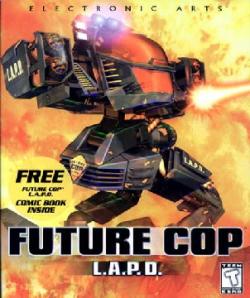
Future Cop: LAPD is a third-person shooter developed by EA Redwood Shores and published by Electronic Arts and released first for the PlayStation, then Mac OS and Microsoft Windows. Future Cop was originally developed as an installment of the Strike series.

Overboard! is a top-down adventure game, released by Psygnosis for the PlayStation and Microsoft Windows in 1997. It employs a light-hearted, all-ages piratical theme. A relatively low-key release for Psygnosis, the game was met with mixed reviews.

Transformers: Mystery of Convoy is a 1986 video game developed by ISCO and published by Takara in Japan for the Famicom. It is based on the Transformers toyline. The game was made available on the Wii's Virtual Console service on June 10, 2008.

Super Life-Form Transformers: Beast Wars Neo is a 1999 Japanese Transformers television animated series, a toy line, and a sequel to Beast Wars II. It was produced by NAS, TV Tokyo, and Ashi Productions. Hozumi Gōda reprised his role as Lio Convoy from Beast Wars II when he appeared in the series. Each episode runs for about 30 minutes and were broadcast in standard 4:3 aspect ratio.
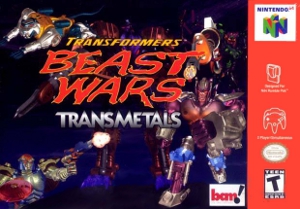
Transformers: Beast Wars Transmetals is a 1999 3D fighting game based on the Transformers: Beast Wars cartoon series and toy-line for the Nintendo 64 and PlayStation. Each version features different mechanics and playable characters.
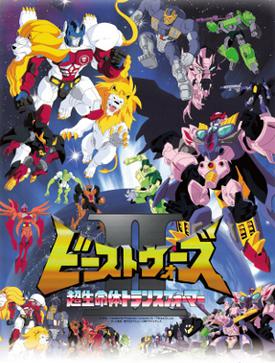
Beast Wars II: Super Life-Form Transformers is a 1998 Japanese Transformers anime series, spawning a movie and a toyline. It was broadcast on TV Tokyo from April 1998 to January 1999, and was the first Transformers anime to be produced by Nihon Ad Systems and animated by the studio Ashi Productions. The series was preceded by Beast Wars: Transformers, and was followed by Super Life-Form Transformers: Beast Wars Neo. The series has a much lighter tone and is aimed more toward children, whereas the more accessible Beast Wars was intended for a wider age-range. The anime uses conventional animation rather than the CGI of its predecessor. With the exception of the faction leaders, all of the characters within the toy-line are either remolds, reissues, or recolors of earlier Beast Wars or Generation 2/Machine Wars toys.
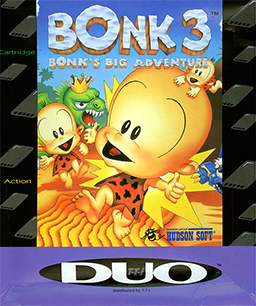
Bonk 3: Bonk's Big Adventure is an action video game released for the TurboGrafx-16 in 1993, the third game in the Bonk video game series.

Machine Hunter is a top-down shooter game developed by Eurocom Entertainment Software, published by MGM Interactive and distributed in Europe by Eidos Interactive. It was developed and released simultaneously in 1997 for Windows 95 and PlayStation console. It has been described as a clone of the 1995 game Loaded, in that it uses an overhead perspective, extensive lighting effects, and over-the-top bloodshed.

Clock Tower, known in Japan as Clock Tower 2, is a survival horror point-and-click adventure game developed by Human Entertainment and released for the PlayStation in 1996. It is the second game in the Clock Tower series after the original Clock Tower, which was released exclusively in Japan for the Super Famicom one year prior. The story takes place in Norway and follows a variety of characters as they attempt to survive the return of Scissorman and uncover the mystery of his seemingly immortal state. The scenarios encountered and endings vary widely based upon the player's actions.
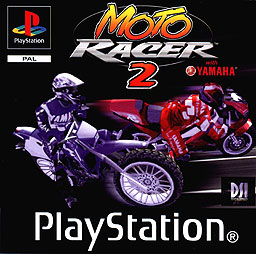
Moto Racer 2 is a motocross racing game developed by Delphine and published by Electronic Arts for PlayStation and Microsoft Windows. It is part of the Moto Racer series, and is the sequel to Moto Racer.

NCAA March Madness 98 was the first installment in the NCAA March Madness series. It was released on February 25, 1998 for the PlayStation. It is the sequel to Coach K College Basketball. Former Wake Forest player Tim Duncan is featured on the cover.
Transformers: Beast Wars is an entertainment franchise from Hasbro and is part of the larger Transformers franchise. The franchise directly follows the Transformers: Generation 1 continuity established by the 1984 series and animated film. It ignores the continuity established by the Japanese Transformers series, though this franchise would have two exclusive Japanese series of its own. Before Beast Wars, Hasbro had attempted to relaunch the original toys and animation as Transformers: Generation 2. Hasbro intended another franchise, titled Transtech, to follow, combining Beast Wars and Generation 1 characters and aesthetics, but this was canceled. Instead, the franchise began a series of reboots, beginning with the Japanese-produced Transformers: Car Robot series, internationally known as Transformers: Robots in Disguise.

Street Fighter EX is a 2D head-to-head fighting game with 3D graphics, originally released as a coin-operated arcade game for the Sony ZN hardware in 1996. It is a spin-off of the Street Fighter series co-produced by Capcom with Arika and was the first game in the series to feature 3D polygon graphics. It was followed by an updated arcade version titled Street Fighter EX Plus, as well as a PlayStation-exclusive home console version titled Street Fighter EX Plus α, both released in 1997. A Nintendo 64 version was also announced for release in 1997, but later cancelled.

Monopoly is a PlayStation video game based on the board game Monopoly, released on November 6, 1997. Developed by Gremlin Interactive and published by Hasbro Interactive, this title was one of many inspired by the property. Despite using the same box art as the 1995 PC version of Monopoly, it is not the same game.

Gamera 2000 is a video game developed by Surveyor Corp. and released by Daiei Digital Entertainment for the PlayStation. The game features the giant monster character Gamera, and was released in Japan on April 25, 1997.


















